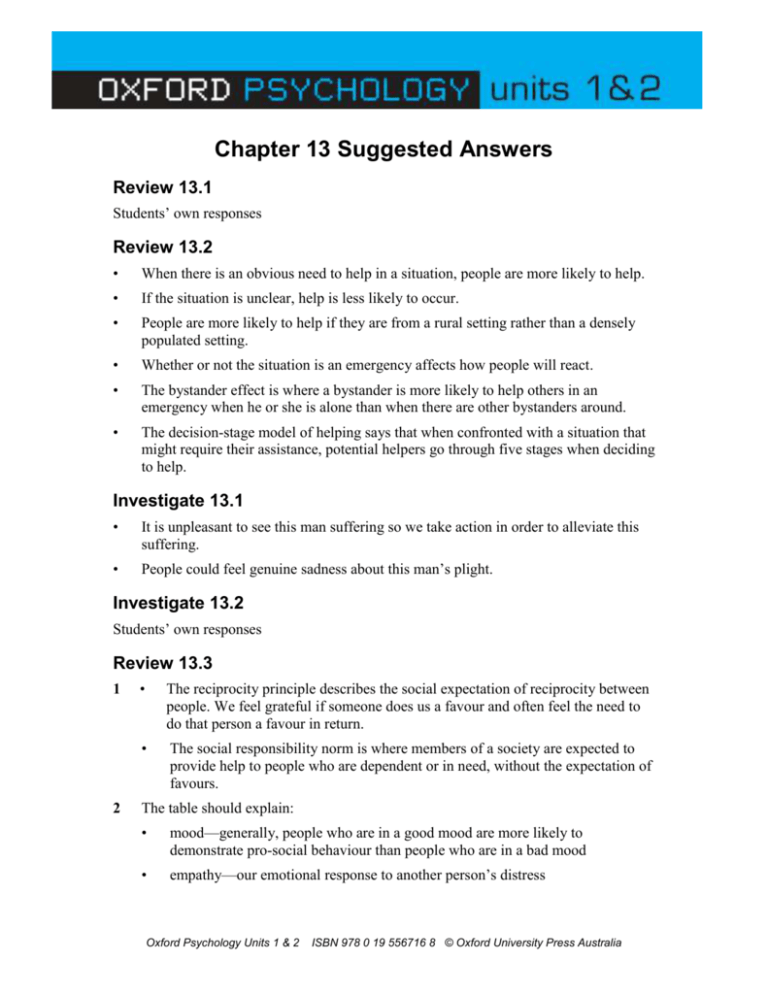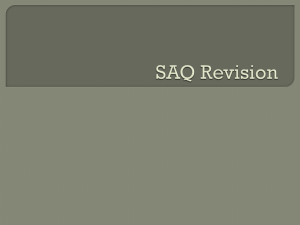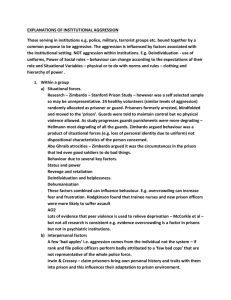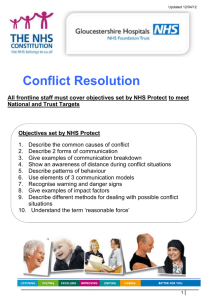Chapter 13 Suggested Answers
advertisement

Jodie Allen Unit 2 AOS 1 Chapter 13 Chapter 13 Suggested Answers Review 13.1 Students’ own responses Review 13.2 • When there is an obvious need to help in a situation, people are more likely to help. • If the situation is unclear, help is less likely to occur. • People are more likely to help if they are from a rural setting rather than a densely populated setting. • Whether or not the situation is an emergency affects how people will react. • The bystander effect is where a bystander is more likely to help others in an emergency when he or she is alone than when there are other bystanders around. • The decision-stage model of helping says that when confronted with a situation that might require their assistance, potential helpers go through five stages when deciding to help. Investigate 13.1 • It is unpleasant to see this man suffering so we take action in order to alleviate this suffering. • People could feel genuine sadness about this man’s plight. Investigate 13.2 Students’ own responses Review 13.3 1 2 • The reciprocity principle describes the social expectation of reciprocity between people. We feel grateful if someone does us a favour and often feel the need to do that person a favour in return. • The social responsibility norm is where members of a society are expected to provide help to people who are dependent or in need, without the expectation of favours. The table should explain: • mood—generally, people who are in a good mood are more likely to demonstrate pro-social behaviour than people who are in a bad mood • empathy—our emotional response to another person’s distress Oxford Psychology Units 1 & 2 ISBN 978 0 19 556716 8 © Oxford University Press Australia Jodie Allen • Unit 2 AOS 1 Chapter 13 personal competence—people who believe they are competent are more likely to help). Investigate 13.3 Personal competence due to his training and altruism. Investigate 13.4 1 • Dependent variable—helping behaviour (seeking help). • Independent variable—group size. 2 Some possible confounding variables include personal competence and the mood of the participants. 3 Participants were volunteer students and not a sample representative of the population. 4 Causing psychological distress/harm to the participants. Investigate 13.5 1 2 • Dependent variable—the time it took to report the smoke. • Independent variable—the presence of others. • Position of participants in the room. (Could they see the smoke clearly?) • Other variables can be accepted. 3 Participants were volunteer students and not a sample representative of the population. 4 Causing psychological distress/harm to the participants. Review 13.4 1 Many examples will be accepted: • diffusion of responsibility—for example, when a crowd of people at a market observe someone falling and dropping their groceries no one helps as they assume someone else will do it • proximity— for example, when a tsunami hits another country, those living in another country may not help the victims as the affected country is far away • audience inhibition— for example, a spectator in the stands may be reluctant to throw a football back to the players at the MCG for fear of people thinking they are hopeless at throwing Oxford Psychology Units 1 & 2 ISBN 978 0 19 556716 8 © Oxford University Press Australia Jodie Allen 2 Unit 2 AOS 1 Chapter 13 • social influence—for example, when an accident on the road occurs and many people stop to help this will influence the likelihood that more people will stop to help • nature of the bystander—for example, a person may not help someone who had broken down on the side of the road due to a negative past experience where they were attacked by someone posing to break down in order to rob them. Students need to provide a suitable chart that shows the following steps and their influence on whether help is given; that is. weighing up the cost: emergency confronted > physiological arousal + labelling + evaluating the consequences = direct help (or no help) given. Investigate 13.6 1 Students’ own responses 2 Perhaps people did not help due to the following factors: • deindividuation—they were amongst a crowd • bystander effect of diffusion of responsibility and social influence—there were others available to help but no one seemed concerned • nature of the bystander—people assumed she was drunk or didn’t need help due to the colour of her skin. Review 13.5 1 Vicarious experience, where one person learns a behavior by watching another person’s behaviour and seeing the consequences of that behaviour. 2 • Hostile aggression is not premeditated. Rather, it occurs impulsively and with high emotion. People often feel remorseful after the incident. • Instrumental aggression is planned and the person feels no remorse. • Top picture—instrumental aggression. • Centre picture—a case for both instrumental and hostile aggression can be argued. • Bottom picture—hostile aggression. 3 Review 13.6 • Genetic explanations—the genes we inherit. • Biochemical explanations—hormones affect aggression. • Neurophysiological explanations—the amygdala and hypothalamus play an important role in stimulating or inhibiting aggressive behavior. Oxford Psychology Units 1 & 2 ISBN 978 0 19 556716 8 © Oxford University Press Australia Jodie Allen Unit 2 AOS 1 Chapter 13 • Psychodynamic explanations—aggression stems from built-up bodily tensions that must be released. • Ethological explanations—evolutionary purpose of aggression, which compares human aggression and instincts with those of animals. Review 13.7 Students’ own responses Investigate 13.7 1 • Dependent variable—imitating aggressive behaviour. • Independent variable—observation of aggressive adult behaviour. 2 Home life of children and prior exposure to aggression. 3 Results can be generalised to children at the Stanford Nursery School and not the wider population as participants were a sample taken from the population of Stanford Nursery School students. 4 • Informed consent would need to be obtained from parents/guardians. • Lasting psychological effects where children continue to play aggressively. Investigate 13.8 1 • Dependent variable—imitating aggressive behaviour. • Independent variable—observation of aggressive behavior live, on video or in cartoon format. 2 Home life of children and prior exposure to aggression and cartoon. 3 Results can be generalised to children at the Stanford Nursery School and not the wider population as participants were a sample taken from the population of Stanford Nursery School students. 4 • Informed consent would need to be obtained from parents/guardians. • Lasting psychological effects where children continue to play aggressively. 5 Students’ own responses (personal response required). Review 13.8 Students’ own responses Investigate 13.9 1 • Dependent variable—imitating aggressive behaviour. Oxford Psychology Units 1 & 2 ISBN 978 0 19 556716 8 © Oxford University Press Australia Jodie Allen • Unit 2 AOS 1 Independent variable—observing consequence for aggression. 2 Home life of children and prior exposure to aggression and cartoon. 3 Results can be generalised to children at the Stanford Nursery School and not the wider population as participants were a sample taken from the population of Stanford Nursery School students. 4 • Informed consent would need to be obtained from parents/guardians. • Lasting psychological effects where children continue to play aggressively. 5 Chapter 13 Observing someone being rewarded or reinforced for behaving aggressively; that is, seeing someone benefit from being aggressive. Investigate 13.10 Students’ own responses Investigate 13.11 Students’ own responses Review 13.9 1 Students’ own responses 2 • Teaching people. • Rewarding or praising pro-social behaviours, and not rewarding (without punishing) anti-social behaviour. • Observing non-aggressive models. • Displaying unpredictable responses. • Teaching the use of cognitive strategies. Test Your Understanding 1 c 2 d 3 c 4 b 5 a 6 c 7 b 8 d Oxford Psychology Units 1 & 2 ISBN 978 0 19 556716 8 © Oxford University Press Australia Jodie Allen 9 Unit 2 AOS 1 Chapter 13 c 10 d 11 d 12 c 13 c 14 c 15 a 16 c 17 d 18 a 19 d 20 a 21 b 22 Pro-social. 23 When confronted with a situation that might require their assistance, potential helpers go through five stages in deciding to help: 1 noticing the need for help 2 deciding that it is an emergency 3 deciding to take responsibility 4 deciding on a way to help 5 taking action to help. 24 Altruism. 25 Bandura. 26 Reciprocity principle, social responsibility norm. 27 The bystander effect. 28 Diffusion of responsibility. 29 Audience inhibition. 30 Be a good role model. 31 Sets the scene as to what is acceptable behavior. 32 Because people often still receive a reward or recognition for their helping behavior and it is hard to discover the real reason for helping. Oxford Psychology Units 1 & 2 ISBN 978 0 19 556716 8 © Oxford University Press Australia Jodie Allen Unit 2 AOS 1 Chapter 13 33 Aggression. 34 Nature, nurture. 35 Ethological explanation. 36 Hot temperature and crowded environment. 37 Evaluate the cost to themselves; that is, being late). 38 • Aggressors have less chance of being identified and the individual characteristics of the victim are less likely to be recognised. • It may be socially acceptable in their culture (e.g. gangs). 39 • Genetic explanations—the genes we inherit. • Biochemical explanations—hormones affect aggression. • Neurophysiological explanations—the amygdala and hypothalamus play an important role in stimulating or inhibiting aggressive behavior. • Psycho-dynamic explanations—aggression stems from built-up bodily tensions that must be released. • Ethological explanations—evolutionary purpose of aggression, which compares human aggression and instincts with those of animals. 40 A person’s genes interact with the environmental influences to determine whether a the person grows up to demonstrate aggressive behaviour. In addition, facets of an individual’s personality (such as impulsivity, level of empathy and need to dominate others) also have an influence. 41 • Teaching people. • Rewarding or praising pro-social behaviours, and not rewarding (without punishing) anti-social behaviour. • Observing non-aggressive models. • Displaying unpredictable responses. • Teaching the use of cognitive strategies. 42 Students’ own responses 43 • The cost-benefit analysis model by Piliavin et al (1981) suggests that when a bystander is confronted with an emergency, he or she weighs up the costs and benefits of providing help compared with those for not helping. • Audience inhibition—the presence of other bystanders or onlookers can make a potential helper feel self-conscious and thus inhibit helping behaviour. 44 Students’ own responses Oxford Psychology Units 1 & 2 ISBN 978 0 19 556716 8 © Oxford University Press Australia Jodie Allen Unit 2 AOS 1 Chapter 13 Assessment Example: Essay Key Knowledge Pro-social and anti-social behaviour of the individual: characteristics of, and factors influencing, pro-social behaviour: situational (bystander intervention and effect), social norms-reciprocity principle; social responsibility norm; personal (empathy, mood, competence); altruism; characteristics of, and factors influencing, anti-social behaviour: diffusion of responsibility; audience inhibition; social influence; cost-benefit analysis. Task • Presentation: Essay. • Word range: Approximately 500 words. • This task will be marked out of 10 and is based on a set of key knowledge and key skills. You have 50 minutes to complete the task and you can access your text book and additional resources, such as worksheets and other texts. In your essay you are to include: – an explanation of the characteristics of pro-social and anti-social behaviour – factors that affect pro-social and anti-social behaviour – examples of how each factor affects either pro-social or anti-social behaviour. Assessment You will be assessed using the following criteria. Assessment criteria Information about key features of pro-social and anti -social behaviour is accurate and comprehensive Description of factors affecting pro-social and anti-social behaviour Accurate examples of pro-social and anti-social behaviour Appropriate structure and coherent language used Citation of all source material and inclusion of a reference list Oxford Psychology Units 1 & 2 Very high High Medium Low Not shown Score /5 /6 /3 /3 /3 /20 ISBN 978 0 19 556716 8 © Oxford University Press Australia







